
|
The WCON-07C and TCON-17C Lens Attachments for the Olympus C-5060wZ and C-7070WZ |

| My other pages related to the Olympus C-5050Z, C-5060WZ, and X-7070WZ |
|
Almost exactly a year after releasing the WCON-07 and TCON-17 for the '5050, Olympus came up with similar attachments for the new C-5060WZ. They also work with the '5060 successor, the C-7070WZ (which is an almost identical camera with 40% more pixels). Here is a full write-up, and some results of my informal testing (or rather try-out) session with these lenses. Basic specs at a glance In addition to the lenses discussed here, I have also included a column with the data on the newer 3x converter, the TCON-30C, discussed in a separate article. |
| Model | WCON-07C | TCON-17C | TCON-30C | Notes |
|---|---|---|---|---|
| Focal length multiplier | 0.7x | 1.7x | 2.9x | |
| Equivalent focal length (mm) | 19 | 187 | 320 | |
| Elements/Groups | 3/3 | 5/3 | 6/3 | |
| Diameter/Length (mm) | 101/40 | 50/60 | 76/88 | [1,5] |
| Weight (g) | 255 | 95 | 200 | [2] |
| Rear mount | Proprietary | Proprietary | Proprietary | |
| Front filter thread (mm) | None | None | None | |
| Minimum focus distance, cm | 35/7 | 200/50 | ?? | [4] |
| U.S. street price | $150 | $150 | $165 | [3] |
|
Notes:
Mechanical The first impression about both lenses, but especially the TCON-17C, is that of plastic. While the previous WCON/TCON pair was also made of that material, in the new ones it is more obviously visible, because of the plastic bayonet mount saying "I'm plastic, I'm cheap, and I'm here to stay". The finish somehow looks not as good as on the older lenses, especially for the new TCON. | ||
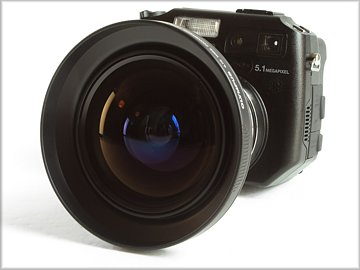
|
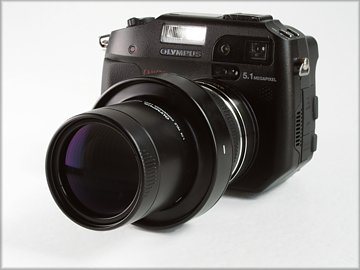
| |
|
The WCON, in spite of its 250g moving the camera's center of gravity forward, still balances well on the body and can be, if needed, operated with one hand. The TCON is so much lighter than its predecessor, that it practically does not change the camera handling. (It just looks somewhat silly, with the mount collar protruding in the middle.) Each lens comes with front and rear push-on caps made of plastic. This a bad solution in general, but for these rear caps especially so. The caps can be pushed on the lens less than 2 mm (stopping at the protruding bayonet mount), which does not give them enough friction surface to stay on. As a result, they fall off easily in the camera bag, exposing the rear lens elements to dirt and/or accidental fingerprints. I consider this unacceptable. Manufacturing costs for a plastic, bayonet-type rear cap must be about 25 cents. Too bad Olympus decided to save on this expense. I had a similar issue with the previous WCON-07 and TCON-17; it was solved by buying two pairs of metal, threaded filter-stacking caps of a 55 mm diameter. Here this solution is not applicable. Too bad. The new bayonet mount — a disaster In these lenses Olympus abandoned the generally-accepted way of mounting auxiliary lenses by means of a filter-like thread. Instead, they opted for a proprietary bayonet mount. This has two immediate results:
The last one may be worked around by getting a third-party lens adapter with a threaded front, and you will have to resort to this option in order to use any other attachment lenses except of the two reviewed here. Actually, I was expecting the bayonet mount to be easier in operation. Not so, the process is really cumbersome, sometimes requiring a third hand. Using a bayonet mount in the front of the lens adapter, while the adapter itself is mounted on the camera by a thread is not a sound design. The bayonet uses friction to secure the lens in place (when it wears off, it will start to wobble), and this requires you to hold the adapter firmly by the middle, to prevent unscrewing it while unlocking the lens attachment. Worse, it is quite easy to err in aligning the three barrel marks, and end up tightening the bayonet only to see the lens fall off, unsecured. It just happened to me while writing this paragraph, a moment ago (luckily, the drop on the carpet was just six inches, no harm done). There may have been two reasons behind this questionable design decision:
I have no proof, of course, but I'm convinced that the second reason (i.e., the corporate greed) was behind the change. A thread, even if partly worn off, still does a good job by securing the surfaces flush against each other. (So does a well-designed bayonet, which is not the case here.) Besides, Olympus still uses a thread to connect the adapter to the camera body. I have been using interchangeable lenses, filters, and other accessories for more than forty years, and I have learned that a bayonet may be a good solution, as long as it meets three requirements: being well-designed, well-made, and made of the right materials. Unfortunately, the bayonet mount system on the new Olympus lenses fails on all three counts. The pictures below, using the same scale, show both lenses mounted on the '5060 with use of the CLA-7 tube. | ||
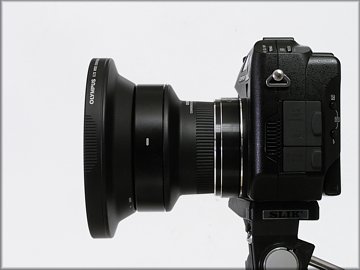
|
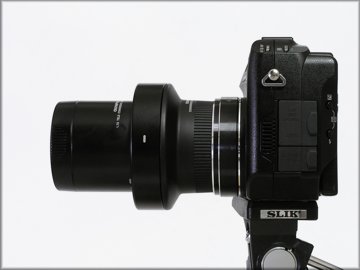
| |
|
Optical When I first saw the announcement of the new lenses, I thought they will be like the previous ones, only in the new, bayonet mounts. Not so. Optically these are new constructions, entirely changed. The WCON-07C has three elements in three groups; the previous version had four. This, of course, is not a fireproof measure of optical quality, but more often than not it is. The rear element has a diameter by 5 mm smaller than that of the older lens. This in spite of the wider lens angle on the '5060 (as compared to the '5050). I would interpret this as a sign that the attachment will not work properly on lenses with wider aperture. If one day Olympus decides to come up with a "super bright wide zoom", you will have to get a new wide-angle attachment lens. This, actually, may be yet another reason behind the proprietary bayonet mount. It prevents the '5050 users from using the new lens and discovering possible vignetting, which would lead to bad feelings. Anyway, the new lens, despite the simplifications, retails at the same price as the old one (actually, the latter can now be bought for less). On the plus side, I experienced no vignetting with this lens at the widest zoom setting, and this is good. What you get, is an equivalent focal length of 19 mm. During my film years, one of my favorite lenses was a 20-35 mm zoom, with the 20 mm setting being about the widest angle practical in non-exotic applications. This angle was the actual reason I decided to buy the WCON-07C. (On the other hand, the EFL of 24 mm, available with the WCON-07 on C-5050Z, is almost as good.) The TCON-17C has the same number of elements and groups as its predecessor. Its diameter is, however, much smaller. The rear element is just 15 mm across (the old one was 35 mm, five times larger area). This means that while the older lens will work with almost any compact-camera zoom at the long end, the new one — only with lenses of limited aperture, like the '5060 at its (disappointing) F/4.8. The assembly also seems to be greatly simplified, to the point of looking cheap. Anyway, while some users will find the smaller size and weight of TCON-17C a plus, it is obvious that the new lens must be much less expensive in manufacturing. It retails, however, at a price similar to the older TCON-17, and I consider this excessive. Filters and hoods Neither of the new attachment lenses has a front accessory thread, so filters or hoods cannot be used, at least not easily. This is understandable in case of the WCON-07C, which has a shallow hood built in (although finished in shiny black inside, not nicely ribbed like the one in the older lens). Any deeper hood, or a filter (at these diameters being prohibitively expensive anyway) may cause vignetting. For the TCON-17B, however, I consider this a serious omission. First, being able to add a corrective or protective filter to this lens would be good. The barrel diameter is only about 50 mm, so actually a construction accepting standard 49 mm filters would be just fine. Second, a hood can improve the contrast of a long lens considerably. This is the best buck-for-the-bang investment for your system. I once spent $60 on a Contax hood for the TCON-14 used with the E-20, and the results were instantly visible. How much would it cost to add a filter thread in the plastic lens barrel? Shame. In the field The close focusing distances are given in the table above, quoted after lens instructions. In any case, you can always switch into the macro mode (the flower icon without an 'S') and the camera will still focus up to infinity, albeit somewhat more slowly (see my '5050 "super macro" article for more on this). The C-5060WZ has a dual, active and passive, focusing system (the '5050 lacks the former). The active system, using an external sensor and an IR beam, will not work properly with attachment lenses, and therefore should be disabled when these are mounted. This is done from the Camera > Accessory submenu. Actually, when shooting outdoors, I would recommend turning the active system off and leaving it there, in order not to dig in the menu every time when mounting or dismounting a lens. The camera will still focus just fine, maybe a bit more slowly (or maybe not), as long as there is enough light. With a proprietary mount, I would imagine it would be possible to provide a way for the camera to automatically detect the presence of a lens attachment, and this would be really useful. Obviously, and this cannot be helped, you have to give up the built-in flash and the optical viewfinder itself. SLRs or cameras with electronic, eye-level viewfinders (did I mention I dislike the latter?) do not suffer from the latter limitation. The monitor may be not very readable in bright, outdoors light. Additionally, holding the camera in front of you in outstretched hands (not against your forehead), makes longer shutter speeds less handholdable. This is important for the TCON. Without a tripod, and holding the camera "normal" way, you can (on average) safely handhold exposures not longer than one over the (equivalent) focal length; in this case 1/200s. Holding it on outstretched hands, I would move this safe limit up by a factor of two, i.e., to 1/400 of a second. Nothing comes without a price. (With some experience and training you can use handheld speeds up to 10x longer, but the deterioration of camera stability when using the LCD still applies.) Here is my pond scene taken at the EFL of 19 mm. All samples shown are taken at ISO 80, saturation, sharpness and contrast at default (zero) settings, saved as SHQ JPEGs. A light tripod was used. For each shot, a reduced and re-sharpened full frame is shown at the left. At the right I'm showing cropped 1:1 (full pixel size) samples from the marked area, cropped and re-saved at low JPEG compression to minimize quality loss. | ||
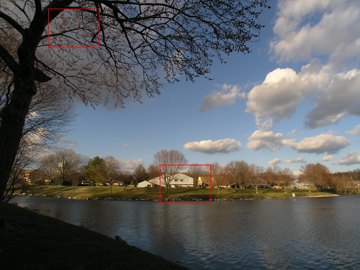
|
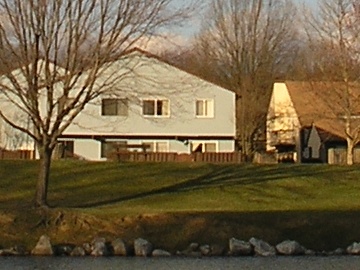
| |
| WCON-07C, EFL = 19 mm, F/4.0 at 1/500s, tripod | Central sample from the image at the left | |
|
This picture was taken at F/4.0, i.e., stopped down by one EV from the maximum aperture. A scrutiny of samples (and I went through some more) shows that, actually, the WCON-17C provides good sharpness and contrast in the center, and quite good in corners, better than I have expected at this effective focal length.
True, some chromatic aberration is visible in the corner, but it is quite moderate. The instruction sheet expressly warns against this when the lens is wide open, but, obviously, at F/4.0, which is a more typical outdoors aperture, things are under control. A respectable job. |
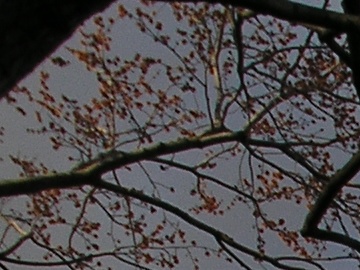
| |
| Corner sample from the same image | ||
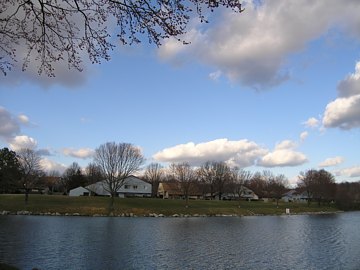
|
For comparison, the thumbnail at left (shot from exactly the same vantage point) shows the field of view of the "naked" lens at the EFL of 27 mm, so that you know what you're getting for your $150.
Quite a dramatic difference. Unfortunately, the picture was shot when the Sun was hiding behind a cloud, so the comparison is not as one-to-one as I would like it to be, but you should get the idea. | |
| No attachment, EFL = 27 mm, F/2.8 at 1/640s | ||
|
With the very good impressions I had on the older TCON-17, the new TCON-17C had big shoes to fill, therefore I was really in anticipation what the samples would show. Here they are. | ||
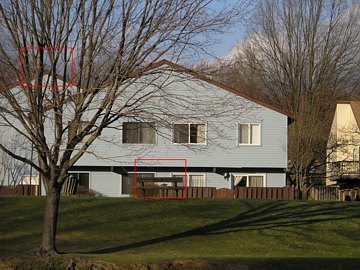
|
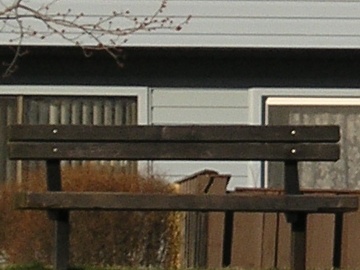
| |
| TCON-17C, EFL=187 mm, aperture priority at F/5.6 and 1/320s, tripod | Central sample from the image at the left | |
|
Surprise! This ugly lens I despise so much is still capable of turning out first-class results!
Believe me: I really dislike this lens, but after having spent half a day going through more than 100 samples, I owe you the truth: this lens is a performer. The images are a tad softer at F/4.8 (slightly more so in the corners), just a half-stop wider, which can be seen by flipping between 1:1 samples with use of a good image viewer (like ACDSee). Still, even at full aperture the quality is good (see the sample below). (Yes, I've checked that even at this focal length there was still plenty of depth of field available, so the corner softening cannot be explained by being out of focus.) |
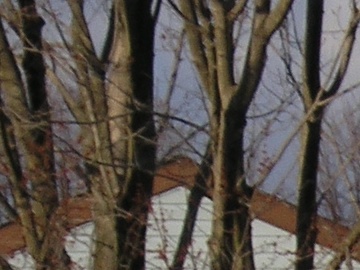
| |
| Corner sample from the same image | ||
|
Of course, I was very eager to compare the TCON-17C (which I dislike so much) against the older TCON-17 (which I like very much). Using the Bowers lens adapter tube (described in another story), I mounted the older lens on the '5060, and here are two samples, taken less than a minute apart (important, as if the light conditions change, so may the contrast, and therefore perceived sharpness). | ||
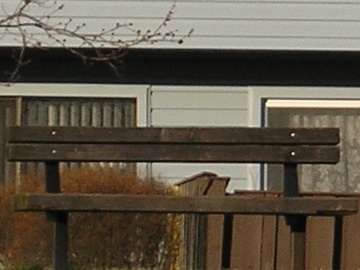
|
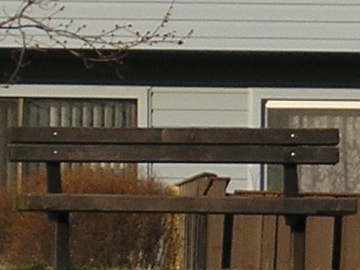
| |
| The "new" TCON-17C, EFL=187 mm, F/4.8 | The "old" TCON-17, EFL=187 mm, F/4.8 | |
|
This is just not right. The new lens has to be worse than the old one. It is not, not optically, not in terms of images it turns out on the C-5060WZ. Maybe just a hint more of softness in corners at full aperture, but, again, with my attitude I may be seeing things. Nothing definite. One ugly lens. One good performer. Conclusions My feelings about these two lenses are mixed. They are of entirely plastic construction, and the TCON-17C just feels cheap. The bayonet mount is unnecessary and cumbersome; the lenses will work with no other camera. The push-on caps are unreliable, especially the rear ones. The TCON-17C lacks the front filter/hood thread. On the other hand, and this is the most important aspect, both lenses are very good performers, providing image quality at par with the previous versions (at least within other possible bottlenecks imposed by the camera). Your other options include the previous attachments from Olympus, or some offerings by independent makers (those I've seen range from awful to respectable; at this moment the new Raynox offerings look most promising). In either case you would have to use a third-party lens adapter of which at least three are available. | ||

| My other pages related to the Olympus C-5050Z, C-5060WZ, and X-7070WZ |
| Home: wrotniak.net | Search this site | Change font size |
| Posted 2004/03/22; last updated 2005/09/06 | Copyright © 2004-2006 by J. Andrzej Wrotniak |